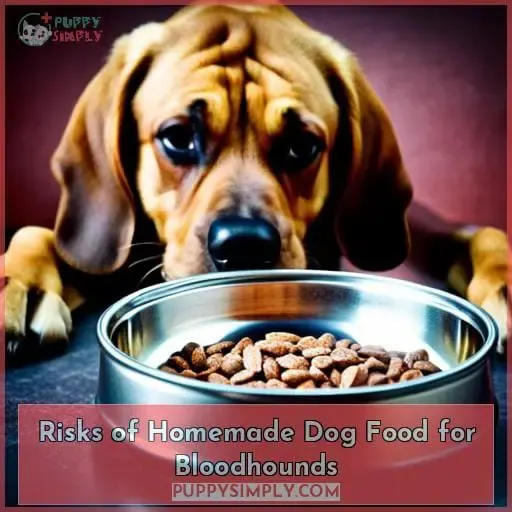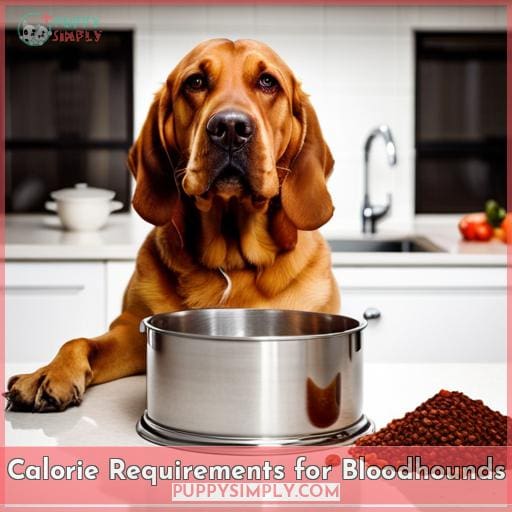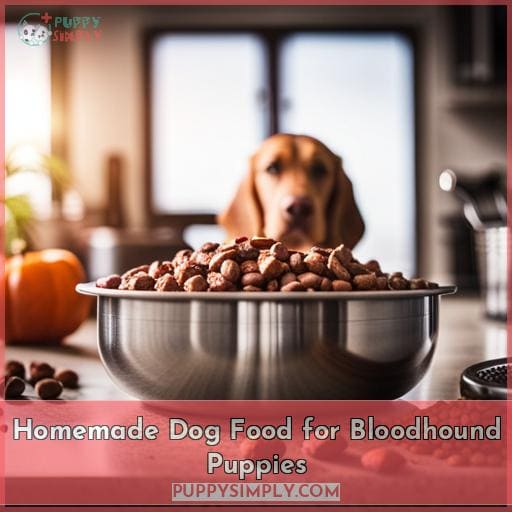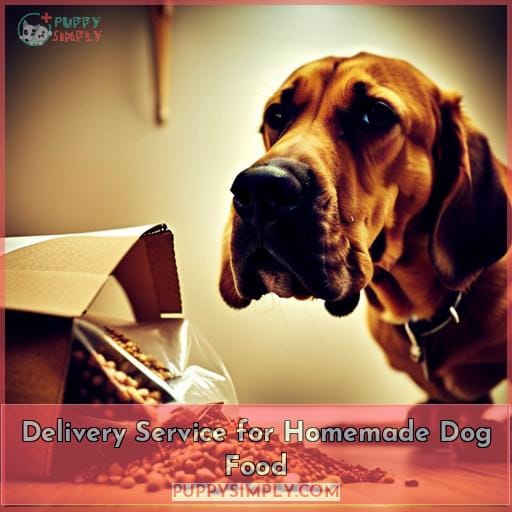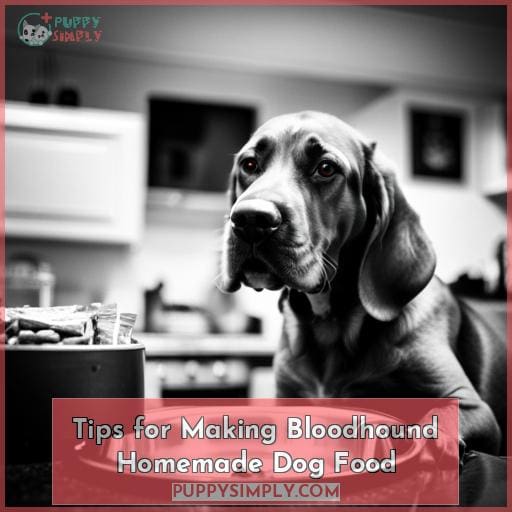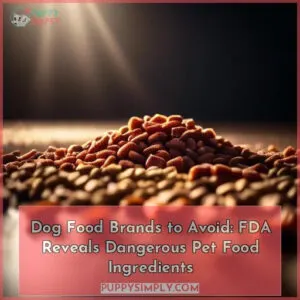This site is supported by our readers. We may earn a commission, at no cost to you, if you purchase through links.
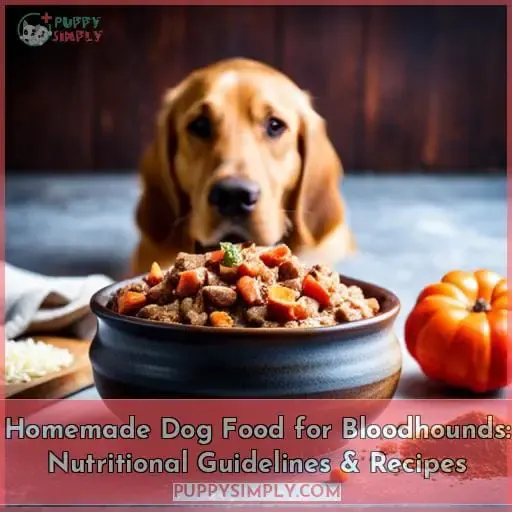 Imagine having the peace of mind that comes with knowing you’re feeding your beloved Bloodhound the healthiest, most nutritious food possible. With homemade dog food for bloodhounds, you can provide them with a balanced diet tailored to their specific needs.
Imagine having the peace of mind that comes with knowing you’re feeding your beloved Bloodhound the healthiest, most nutritious food possible. With homemade dog food for bloodhounds, you can provide them with a balanced diet tailored to their specific needs.
In this article, we’ll explore nutritional guidelines and share delicious recipes that will keep your furry friend happy and healthy. Discover how homemade dog food can make a positive impact on your Bloodhound’s overall well-being.
Table Of Contents
- Key Takeaways
- Bloodhound Homemade Dog Food Benefits
- Why Feed Homemade Food to Bloodhounds?
- Risks of Homemade Dog Food for Bloodhounds
- Nutritional Guidelines for Bloodhound Homemade Dog Food
- Dietary Changes for Bloodhound Health
- Calorie Requirements for Bloodhounds
- Homemade Dog Food for Bloodhound Puppies
- Delivery Service for Homemade Dog Food
- Tips for Making Bloodhound Homemade Dog Food
- Frequently Asked Questions (FAQs)
- Can I use raw grass-fed goat milk as a probiotic supplement?
- How often should I feed chicken feet to my small dog?
- How do I keep the grinding parts of my Weston grinder from rusting?
- What is the shelf life of homemade dog food supplements?
- Are there any recommended books or resources for homemade dog food recipes and guidelines?
- Conclusion
Key Takeaways
- Improves overall health and well-being
- Helps avoid allergies
- Promotes healthy joints
- Enhances bioavailability of nutrients
Bloodhound Homemade Dog Food Benefits
When it comes to feeding your Bloodhound homemade dog food, there are several benefits to consider.
Homemade dog food can help increase their lifespan by providing them with a balanced and nutritious diet.
It also allows you to avoid potential allergies and helps prevent obesity and joint issues that are common in this breed.
By following the nutritional guidelines and recipes specifically designed for Bloodhounds, you can ensure that your furry friend is getting all the necessary nutrients they need for optimal health.
Health benefits of homemade dog food for Bloodhounds
One of the main benefits of homemade dog food for Bloodhounds is its ability to improve their overall health and well-being.
Homemade dog food can help increase their lifespan, avoid allergies, promote healthy joints by preventing obesity, and enhance bioavailability of nutrients.
It also has potential cancer prevention properties due to the use of fresh ingredients rich in antioxidants.
Additionally, homemade dog food can contribute to a shiny coat color while addressing concurrent GI signs such as dull coat & scaling, dandruff & crustiness.
Nutritional guidelines for Bloodhound homemade dog food
How can you ensure that your homemade dog food for Bloodhounds meets their nutritional needs?
When preparing homemade dog food for your Bloodhound, it’s important to follow certain guidelines to ensure proper nutrition.
Follow the 80/10/10 rule, which means feeding:
- 80% boneless muscle meat
- 10% organ meat
- 10% bone
Maintain a calcium to phosphorus ratio between 1:1 and 2:1 by adding around 800-1000 mg of calcium per pound of meat and organs fed.
Incorporate supplements as needed and store the food properly in portions according to preference.
Homemade dog food recipes for Bloodhounds
To continue reaping the health benefits of homemade dog food for your Bloodhound, try these delicious and nutritious recipes that are tailored to meet their specific dietary needs.
For a chicken and rice delight, combine cooked chicken breast with brown rice and vegetables like carrots and peas.
The turkey, vegetable, and quinoa feast includes ground turkey meat mixed with cooked quinoa and an assortment of veggies.
Lastly, the beefy & veggie medley combines lean ground beef with sweet potatoes, green beans, and spinach for a nutrient-packed meal option.
Why Feed Homemade Food to Bloodhounds?
Feeding homemade food to your Bloodhound can provide numerous health benefits.
By opting for a homemade diet, you can help:
- Increase their lifespan
- Avoid allergies that may be triggered by commercial dog food
- Maintain a healthy weight, reducing the risk of obesity and joint issues commonly seen in Bloodhounds
- Offer better bioavailability of nutrients compared to processed foods, which aids in cancer prevention
Providing your Bloodhound with fresh, nutritious meals tailored specifically to their needs ensures they receive optimal nutrition for overall well-being.
Key Benefits:
- Increased lifespan
- Allergy avoidance
- Prevention of obesity & joint problems
Risks of Homemade Dog Food for Bloodhounds
When making homemade dog food for your Bloodhound, it’s important to be aware of the potential risks involved.
One major risk arises from imprecise determination of ingredients and quantities.
Not knowing how much food to serve per meal can lead to overfeeding or underfeeding, which can have negative health effects on your Bloodhound.
Another risk is purposely changing the recipe without understanding the nutritional implications.
Additionally, not measuring the proportions of the ingredients well may also lead to an unbalanced diet and nutrient deficiencies.
According to a study, 28.3% of homemade dog food recipes didn’t use any recommended vitamins, minerals, or amino acids necessary for a complete and balanced canine diet (Source: Journal of Small Animal Practice).
It’s crucial to prioritize bloodhound food safety by carefully selecting ingredients and following appropriate guidelines when preparing homemade meals for your beloved pet.
Nutritional Guidelines for Bloodhound Homemade Dog Food
You should consider the nutritional guidelines for homemade dog food when preparing meals for your Bloodhound.
To ensure a balanced diet, it’s important to follow these guidelines.
First, maintain a calcium to phosphorus ratio between 1:1 and 2:1 by adding 800-1,000 mg of calcium per pound of meat and organ fed.
Second, feed a variety of protein sources such as beef, chicken, turkey and include different types of organs like liver or kidney.
Additionally, incorporate fruits and vegetables into their diet by pureeing them for easy digestion.
Don’t forget to grind all meat and bones before feeding your Bloodhound to prevent any choking hazards or digestive issues.
By following these nutritional guidelines in preparing homemade dog food for your Bloodhound pupp,y you can ensure they receive the necessary nutrients they need without relying solely on commercial brands that may contain fillers or preservatives.
Dietary Changes for Bloodhound Health
To promote optimal health and address specific concerns, it’s important to make dietary changes for your Bloodhound.
-
Address Coat Color Changes:
Dietary deficiencies or imbalances can lead to coat color changes in Bloodhounds. By ensuring a balanced diet with proper nutrients, you can help maintain the vibrant coat color of your furry friend.
-
Alleviate Concurrent GI Signs:
Bloodhounds may experience gastrointestinal issues such as diarrhea or vomiting alongside other symptoms like itching or dull coats. Adjusting their diet can help alleviate these concurrent signs and improve overall digestive health.
-
Improve Chronic Itching and Dull Coat:
Dry skin conditions like chronic itching, dandruff, crustiness, and a dull coat are common among Bloodhounds due to various factors including allergies or nutrient deficiencies in their diet.
By making appropriate dietary modifications tailored to the specific needs of your bloodhound breed—such as addressing hip dysplasia,luxating patella,dry eye,and heart disease—you will be able to support their overall well-being through improved nutrition.
Calorie Requirements for Bloodhounds
To ensure optimal health and weight management for your Bloodhound, it’s crucial to determine their specific calorie requirements.
The calorie needs of a Bloodhound can vary based on factors such as age, size, activity level, and health conditions.
Adult Bloodhounds usually weigh between 80 and 100 pounds, meaning most Bloodhounds need between 1449 and 1714 calories daily.
However, pregnant or lactating Bloodhounds may require up to two to four times the amount of food they usually need due to increased energy requirements during this period.
It’s important to consult with your veterinarian for an accurate assessment of your individual dog’s calorie needs in order to provide them with the right amount of homemade dog food for optimal nutrition and overall well-being.
Homemade Dog Food for Bloodhound Puppies
When preparing homemade dog food for Bloodhound puppies, it’s important to provide them with a balanced and nutritious diet that supports their growth and development.
Puppies have specific nutritional needs during this crucial stage of their lives. Focus on high-quality proteins like lean meats, such as chicken or turkey, to support muscle development. Incorporate carbohydrates from sources like sweet potatoes or brown rice for energy.
Healthy fats from sources like fish oil are essential for brain development and a shiny coat. It’s also important to introduce a variety of fruits and vegetables into their diet for added vitamins and minerals.
Be mindful of any potential food allergies your puppy may have when selecting ingredients.
To ensure proper digestion, you can add supplements such as probiotics that promote healthy gut flora in growing puppies. Homemade dog food allows you to control the quality of ingredients while providing your Bloodhound puppy with the nutrients they need at an affordable cost compared to commercial options.
Remember that feeding homemade dog food requires careful preparation and attention to detail in order to meet all nutritional requirements for growing puppies.
Delivery Service for Homemade Dog Food
If you’re looking for convenience and high-quality homemade dog food tailored to your Bloodhound’s unique dietary needs, consider using a delivery service.
These services offer the convenience of having fresh, homemade dog food delivered right to your doorstep.
One popular option is Nom Nom, which offers a variety of recipes made with real, human-grade ingredients.
They also take into account any health conditions or nutritional goals that your Bloodhound may have.
Delivery times vary depending on location and availability but are usually within a few days of placing an order.
When comparing the cost of delivery service to buying ingredients and making homemade dog food yourself, it’s important to factor in the time saved as well as the quality control provided by these services.
Many delivery services also provide customer reviews so you can see what other pet owners think about their products before making a decision.
Tips for Making Bloodhound Homemade Dog Food
One important tip for making homemade dog food for Bloodhounds is to ensure you use a variety of protein sources, types of organs, fruits, veggies, and extras in their meals. This helps provide the necessary nutrients and prevents nutritional deficiencies.
Here are some tips to keep in mind when preparing homemade dog food for your Bloodhound:
- Balance calcium to phosphorus ratio between 1:1 and 2:1
- Feed 80% boneless muscle meat
- Include 10% organ meat
- Add 10% bone
To meet their calcium needs, it’s recommended to add around 800-1,000 mg of calcium per pound of meat and organ fed.
it’s important to grind all meat and bones before feeding them.
Pureeing vegetables and fruits can also help with digestion.
Store the prepared food in portions according to your preference,
and freeze any extra batches that won’t be eaten within three days.
By following these tips, you can ensure that your Bloodhound receives a balanced diet through homemade dog food preparation while meeting their specific nutritional requirements.
Frequently Asked Questions (FAQs)
Can I use raw grass-fed goat milk as a probiotic supplement?
Yes, raw grass-fed goat milk can be used as a probiotic supplement for your dog. It contains natural probiotics that can support gut health and digestion. However, consult with your veterinarian to ensure it’s appropriate for your dog’s specific needs.
How often should I feed chicken feet to my small dog?
Feed chicken feet to your small dog 2-3 times a week.
They’re high in fat and can be beneficial for their overall health.
Remember to balance their diet with other protein sources and consult with your veterinarian for specific recommendations.
How do I keep the grinding parts of my Weston grinder from rusting?
To keep the grinding parts of your Weston grinder from rusting, rub cooking oil on them regularly. This simple step will prevent corrosion and ensure that your grinder stays in optimal condition for preparing homemade dog food.
What is the shelf life of homemade dog food supplements?
The shelf life of homemade dog food supplements is typically around 2 months when stored in a cool place away from sunlight and moisture. This ensures the freshness and effectiveness of the supplements for your dog’s health.
Are there any recommended books or resources for homemade dog food recipes and guidelines?
For recommended books on homemade dog food recipes and guidelines, you can check out:
- Healthy Foods for Dogs and Cats by Becker/Shaw
- Unlocking the Canine Ancestral Diet by Steve Brown
- Explore brands like The Honest Kitchen’s Preference or Dr. Harvey’s.
Conclusion
To ensure the health and well-being of your Bloodhound, homemade dog food is a fantastic option. By following nutritional guidelines and incorporating these recipes into their diet, you can provide your furry friend with the best possible nutrition.
Homemade dog food for Bloodhounds offers numerous benefits, including improved overall health and the ability to tailor their diet to their specific needs. With proper planning and preparation, you can give your Bloodhound the peace of mind that comes with knowing they’re eating nutritious and delicious meals.



